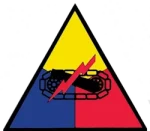S/Sgt. Sam Mike Manfredi in Clancy, Pennsylvania, on October 24, 1920, to Nicholas and Angeline Manfredi, and had six sisters and two brothers. His family resided at 1110 North Nineteenth Avenue, Melrose Park, Illinois. He graduated from Melrose Park School and then attended Proviso Township High School but left before his class graduated. After he left high school, he worked at American Can Company, Maywood, Illinois.
On February 16, 1942, he registered with Selective Service and name his father as his contact person. He was drafted into the US Army on October 21, 1942, in Chicago, and was issued the serial number 36 615 401. His scores on his Army General Classification Test were high, so he was offered the opportunity to join the Air Corps which he accepted. It is not known where he trained but it is known he qualified as a gunner at Lowry Field, Colorado. He joined the 371st Bomb Squadron, 307th Bombardment Group (Heavy), 13th Air Force as a replacement, but the exact date as to when he joined the 371st is not known. The squadron flew B-24J Liberators, and it is known he was a member of the crew of 1st Lt. Edward J. Rice’s plane 44-40611. The other members of the crew were: 1st Lt. Kenneth D. Smith, co-pilot; 1st Lt. Marcel Bilder, Navigator; 1st Lt. Lester P. Brown Jr. bombardier; T/Sgt. Benjamin T. Tampio, engineer; S/Sgt. Sol Stein, assistant engineer; T/Sgt. Thomas N. Silko, radio operator; S/Sgt. Donald E. Reed, assistant radio operator; S/Sgt. Earle W. Painter, armorer gunner; and T/Sgt. Tommy W. Griggs, radio operator/gunner.
Sam most likely was with the 37th when the squadron took part in the air raid on Rabaul, New Guinea, on November 11, 1943. despite the heavy anti-aircraft fire and large numbers of Japanese Zeros, the planes dropped their bombs devasting the Japanese ships in the lagoon. He also most likely flew missions against Yap Island, Truk Island , Palau Island, and Balikpapan Island.
It was on July 5, 1944, that Sam’s plane flew its final mission against Yap. The planes flew out of Mokerang Airfield on the northwest tip of Los Negros Island, New Guinea. The following is the statement made by 2nd Lt. Howard W. Johnson, the pilot of another plane, on July 8, 1944.
“About 15 minutes after the fight started, Lt. Rice feathered #1 engine, which seemed to have been hit by a 20 mm. shell. He was apparently having some trouble doing this as the operation was repeated several times. The enemy seeing that he was in trouble, immediately concentrated on his plane and made a great number of passes. A little later on, his #3 engine started smoking. All this time the formation was staying with him acting as cover and losing altitude and dropping to an IAS (Instrument Air Speed) of 140 MHP. After the enemy fighters left, Lt. Rice was still losing altitude and flying speed, with his plane smoking at the right wing root and flames appearing at that point. It was about this time that he called me over the VHF and told me that he was going to have to make a water landing. From my position, flying on his left wing, it was evident that the fire was getting out of control and he started a series of fairly steep dives and pullouts. After the third pullout I saw five men of his crew bail out at 2,500 feet; three through the camera hatch and two through the bomb bays.. I saw the last chute open after the plane fell off on its left wing and down under my plane. This indicated to me that Lt. Price and the co-pilot had left the controls to jump. By this time the whole plane was on fire, starting at the right wing root and coming out of the waist windows. I then saw the plane crash into the water and explode on impact. After I saw the plane crash, I started circling the area in which the five men had bailed out and saw all five swimming in the water. I circled the area for almost 25 minutes and during this time members of my crew dropped a 5 men life raft and I saw one of the men swimming toward it. There was another plane from the 424th Squadron circling the area and also dropped a life raft. I saw another life raft floating on the ocean and I presumed that this was from Lt. Rice’s plane. The closest man to any of the life rafts was about 300 yards away. Being I was low on gas I then returned to Base.
It is known that three planes were sent to the area and searched for the five men and apparently found no one. In an after action statement for the 307th Bomb Group, it was stated that it was believed that none of the men in the water survived.
Sam’s parents received a telegram from the War Department.
MRS ANGELINA MANFREDI
1110 BROADWAY
MELROSE PARK ILLINOIS
THE SECRETARY OF WAR DESIRES ME TO EXPRESS HIS DEEP REGRET THAT YOUR SON SERGEANT SAM M MANFREDI HAS BEEN REPORTED MISSING IN ACTION SINCE FIVE HULY IN SOUTHWEST PACIFIC AREA PERIOD IF FURTHER DETAILS OR OTHER INFORMATION ARE RECEIVED YOU WILL BE PROMPTLY NOTIED PERIOD
ULIO
THE ADJUTANT GENERAL
On July 6, 1945, a declaration of death as made in the cases of the members of Sam’s crew. His parents received a letter, but the content of the letter is not known.
After the war, Sgt. Sam M. Manfredi’s name was placed on the Walls of the Missing at the new American Military Cemetery outside of Manila, Philippine Islands. He was posthumously awarded the Purple Heat, Bronze Star, and Silver Star with 5 Oak Leaf Clusters.






